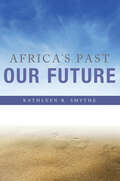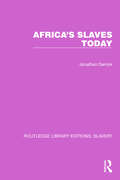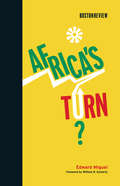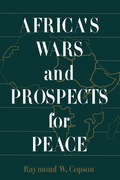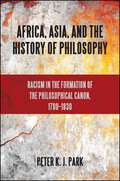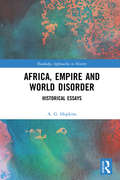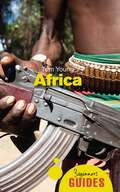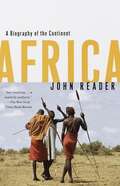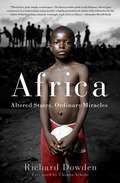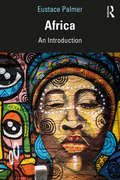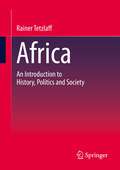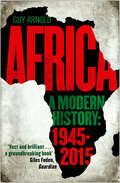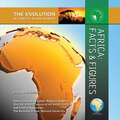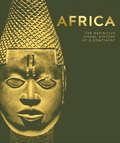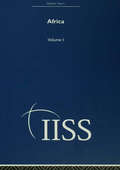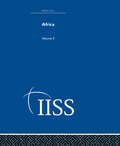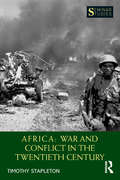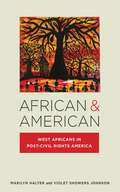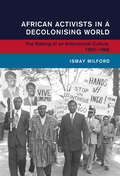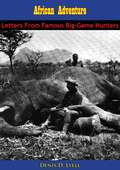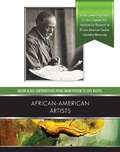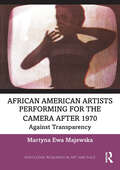- Table View
- List View
Africa's Past, Our Future
by Kathleen R. SmytheAfrica's Past, Our Future engages the history of the African continent through the perspective of global issues such as political instability, economic development, and climate change. Since the past may offer alternative models for thinking about our collective future, this book promotes an appreciation for African social, economic, and political systems that have endured over the long-term and that offer different ways of thinking about a sustainable future. Introducing readers to the wide variety of sources from which African history is constructed, the book's ten chapters cover human evolution, the domestication of plants and animals, climate change, social organization, the slave trade and colonization, development, and contemporary economics and politics.
Africa's Slaves Today (Routledge Library Editions: Slavery #2)
by Jonathan DerrickAfrica’s Slaves Today, first published in 1975, examines the question of the persistence of slavery in modern Africa. It concludes that slavery is by no means dead in certain regions, but that at the same time clear-cut definitions of ‘slave’ and ‘free’ are often impossible to establish. In the Sahara particularly centuries of tradition involving slavery or semi-slavery have ensured a persistence of the status quo in all but name. Recent instances of Africans sold into slavery in Arabia are discussed, together with a detailed survey of slavery throughout North Africa and Ethiopia. At what stage forced labour becomes slavery is a difficult question raised by the discussion of the white South. The whole subject of slavery is put into perspective by contrasting examinations of the historical situation throughout the book.
Africa's Turn? (Boston Review Books)
by Edward MiguelSigns of hope in sub-Saharan Africa: modest but steady economic growth and the spread of democracy.By the end of the twentieth century, sub-Saharan Africa had experienced twenty-five years of economic and political disaster. While “economic miracles” in China and India raised hundreds of millions from extreme poverty, Africa seemed to have been overtaken by violent conflict and mass destitution, and ranked lowest in the world in just about every economic and social indicator. Working in Busia, a small Kenyan border town, economist Edward Miguel began to notice something different starting in 1997: modest but steady economic progress, with new construction projects, flower markets, shops, and ubiquitous cell phones. In Africa's Turn? Miguel tracks a decade of comparably hopeful economic trends throughout sub-Saharan Africa and suggests that we may be seeing a turnaround. He bases his hopes on a range of recent changes: democracy is finally taking root in many countries; China's successes have fueled large-scale investment in Africa; and rising commodity prices have helped as well. Miguel warns, though, that the growth is fragile. Violence and climate change could derail it quickly, and he argues for specific international assistance when drought and civil strife loom. Responding to Miguel, nine experts gauge his optimism. Some question the progress of democracy in Africa or are more skeptical about China's constructive impact, while others think that Miguel has underestimated the threats represented by climate change and population growth. But most agree that something new is happening, and that policy innovations in health, education, agriculture, and government accountability are the key to Africa's future.ContributorsOlu Ajakaiye, Ken Banks, Robert Bates, Paul Collier, Rachel Glennerster, Rosamond Naylor, Smita Singh, David N. Weil, and Jeremy M. Weinstein
Africa's Wars and Prospects for Peace
by Raymond W. CopsonA collection of articles addressing the issue of whether the industrial model of human progress can be sustained in the long term. It asks what the social, political, economic and environmental implications as well as potential solutions to the problem of resource-intensive growth are.
Africa, Asia, and the History of Philosophy: Racism in the Formation of the Philosophical Canon, 1780–1830 (SUNY series, Philosophy and Race)
by Peter K. ParkWinner of the 2016 Frantz Fanon Prize for Outstanding Book in Caribbean Thought presented by the Caribbean Philosophical AssociationIn this provocative historiography, Peter K. J. Park provides a penetrating account of a crucial period in the development of philosophy as an academic discipline. During these decades, a number of European philosophers influenced by Immanuel Kant began to formulate the history of philosophy as a march of progress from the Greeks to Kant—a genealogy that supplanted existing accounts beginning in Egypt or Western Asia and at a time when European interest in Sanskrit and Persian literature was flourishing. Not without debate, these traditions were ultimately deemed outside the scope of philosophy and relegated to the study of religion. Park uncovers this debate and recounts the development of an exclusionary canon of philosophy in the decades of the late eighteenth and early nineteenth centuries. To what extent was this exclusion of Africa and Asia a result of the scientization of philosophy? To what extent was it a result of racism?This book includes the most extensive description available anywhere of Joseph-Marie de Gérando's Histoire comparée des systèmes de philosophie, Friedrich Schlegel's lectures on the history of philosophy, Friedrich Ast's and Thaddä Anselm Rixner's systematic integration of Africa and Asia into the history of philosophy, and the controversy between G. W. F. Hegel and the theologian August Tholuck over "pantheism."
Africa, Empire and World Disorder: Historical Essays (Routledge Approaches to History)
by A. G. HopkinsThis volume brings together important articles from the Cambridge historian A. G. Hopkins and reflect the enlargement and evolution of historical studies during the last half century. The essays cover four of the principal historiographical developments of the period: the extraordinary revolution that has led to the writing of non-Western indigenous history; the revitalization of new types of imperial history; the now ubiquitous engagement with global history, including a reinterpretation of American Empire, and the current revival of economic history after several decades of neglect.
Africa: A Beginner's Guide (Beginner's Guides)
by Tom YoungVast, diverse, dynamic, and turbulent, the true nature of Africa is often obscured by its poverty-stricken image. In this controversial guide, Tom Young cuts through the emotional hype to critically analyse the continent's political history and the factors behind its dismal economic performance. Maintaining that colonial influences are often overplayed, Young argues that much blame must lie with African governments themselves and that Western aid has often caused more harm than good.
Africa: A Biography of the Continent
by John ReaderIn 1978, paleontologists in East Africa discovered the earliest evidence of our divergence from the apes: three pre-human footprints, striding away from a volcano, were preserved in the petrified surface of a mudpan over three million years ago. Out of Africa, the world's most ancient and stable landmass, Homo sapiens dispersed across the globe. And yet the continent that gave birth to human history has long been woefully misunderstood and mistreated by the rest of the world. <p><p> In a book as splendid in its wealth of information as it is breathtaking in scope, British writer and photojournalist John Reader brings to light Africa's geology and evolution, the majestic array of its landforms and environments, the rich diversity of its peoples and their ways of life, the devastating legacies of slavery and colonialism as well as recent political troubles and triumphs. Written in simple, elegant prose and illustrated with Reader's own photographs, this is an unforgettable book that will delight the general reader and expert alike.
Africa: Altered States, Ordinary Miracles
by Chinua Achebe Richard DowdenAfter a lifetime's close observation of the continent, one of the world's finest Africa correspondents has penned a landmark book on life and death in modern Africa. In captivating prose, Dowden spins tales of cults and commerce in Senegal and traditional spirituality in Sierra Leone; analyzes the impact of oil and the internet on Nigeria and aid on Sudan; and examines what has gone so badly wrong in Zimbabwe, Rwanda, Burundi, and the Congo. From the individual stories of failure and success comes a surprising portrait of a new Africa emerging--an Africa that, Dowden argues, can only be developed by its own people. Dowden's master work is an attempt to explain why Africa is the way it is and calls for a re-examination of the perception of Africa as "the dark continent." He reveals it as a place of inspiration and tremendous humanity.
Africa: Altered States, Ordinary Miracles (African Arguments Ser.)
by Richard DowdenAfter a lifetime’s close observation of the continent, one of the world’s finest Africa correspondents has penned a landmark book on life and death in modern Africa. It takes a guide as observant, experienced, and patient as Richard Dowden to reveal its truths. Dowden combines a novelist’s gift for atmosphere with the scholar’s grasp of historical change as he spins tales of cults and commerce in Senegal and traditional spirituality in Sierra Leone; analyzes the impact of oil and the internet on Nigeria and aid on Sudan; and examines what has gone so badly wrong in Zimbabwe, Rwanda, Burundi, and the Congo. Dowden’s master work is an attempt to explain why Africa is the way it is, and enables its readers to see and understand this miraculous continent as a place of inspiration and tremendous humanity.
Africa: An Introduction
by Eustace PalmerAfrica: An Introduction invites you into Africa: a continent rich with culture and history, with diverse populations stretching from the dense tropical rain forest of the Congo basin, right up to the Sahara Desert in the north, and down to the Mediterranean climates of the far south. Containing fifty-five countries, and covering over 20 percent of the world’s landmass, Africa is the birthplace of humanity, yet the image of Africa in the West is often negative, that of a continent riddled with endemic problems. This accessible and engaging guide to the African continent guides the reader through the history, geography, and politics of Africa. It ranges from the impact of slavery and imperialism through to the rise of African nationalism and the achievement of independence, and up to the present moment. Key topics covered include literature, art, technology, religion, the condition of African women, health, education, and the mounting environmental concerns faced by African people. As Africa moves beyond the painful legacies of slavery and imperialism, this book provides an engaging, uplifting, and accessible introduction to a rapidly modernizing and diverse continent. Suitable for high school and undergraduate students studying Africa, this book will also serve as the perfect introduction for anyone looking to understand the history of Africa and the Africa of today.
Africa: An Introduction to History, Politics and Society
by Rainer TetzlaffThe textbook provides an in-depth overview of African history and politics from the Atlantic slave trade, through the phases of colonialism and decolonization, to the development problems of the present. Various development theories are used to explain successful and failed development paths of individual countries after 1960. Thematic foci include Europe's colonial legacy, state formation and state failure, democratization, the curse of raw materials, population growth, hunger and poverty, ethnic conflicts, and the roles of the World Bank, EU, and China as external actors in Africa.
Africa: Crossing The Rubicon
by Guy ArnoldThe end of World War II signaled the end of the European African empires. In 1945, four African countries were independent; by 1963, 30 African states created the Organization of African Unity. The 1960s were a time of optimism as Africans enjoyed their new independence, witnessed increases in prosperity and prepared to tackle their political and economic problems in their own way. By the 1990s, however, these high hopes had been dashed. Dictatorship by strongmen, corruption, civil wars and genocide, widespread poverty and the interventions and manipulations of the major powers had all relegated Africa to the position of an aid "basket case," the world's poorest and least-developed continent. By exploring developments over the last 15 years, including the impact of China, new IT technology and the Arab Spring, the rise of Nigeria as Africa's leading country and the recent refugee crisis, Guy Arnold brings his landmark history of modern Africa up to date and provides a fresh perspective on this misunderstood continent.
Africa: Dilemmas of Development and Change
by Peter LewisEssays on common problems and challenges evident during four decades of postindependence development in Africa.
Africa: Facts & Figures (The Evolution of Africa's Major Nations)
by William Mark HabeebAfrica, the world's second-largest continent, is home to more than 50 countries. Africa has valuable resources, from large reserves of oil to minerals such as diamonds and gold; as well as an incredible variety of wild animals, plants, and trees. From the bustling cities of Egypt to the warm grasslands of Kenya, Africa is filled with diverse cultures and peoples. Yet Africa is also a continent with many problems. African countries are among the world's poorest. Hunger is common, and jobs are rare. Many countries are torn by ongoing wars. Others are devastated by disease--it is estimated that nearly 10 percent of Africans are infected with the virus that causes AIDS, for example. Africa: Facts & Figures gives an overview of the natural features, history, economy, and cultures of this fascinating continent.
Africa: The Definitive Visual History of a Continent (DK Definitive Visual Histories)
by DKImmerse yourself in Africa's vast and intricate story and discover Africa&’s true place in world history.Spanning more than 200,000 years, from the emergence of the first humans to the rise of megacities, Africa explores the history and cultures of the world&’s second-largest continent in vivid detail. It brings to life the stories that shaped Africa and the world around it, from powerful and influential empires and kingdoms such as Mali and Benin, through the struggle against colonization and the fight for independence to Africa&’s place on the global stage today.You will meet some of Africa&’s most important political and military leaders, including Hannibal, Mansa Musa, Oba Ewuare, Queen Nzinga, Kwame Nkrumah, Nelson Mandela, and Ellen Sirleaf. Brilliant photography showcases the great art and architecture that African civilizations have created while engaging text written by experts of African heritage covers every facet of African cultures, from music and literature to oral traditions and languages. Specially commissioned CGI artworks recreate iconic buildings and life in lost cities like Timbuktu and Great Zimbabwe.Explore the pages of this awe-inspiring African history book to discover: -The whol-e story of the African continent, covering every aspect from culture and trade to politics and society-The chapters explore developments in religion, languages, music, literature, and mythology.-Biography sections portray the lives, impact, and legacy of influential figures in African history.-Detailed maps set the main sites in context and showcase vast empires and key trade routes-Optional 80-page reference section provides a directory of the histories and cultures of all the sovereign states in Africa.Beautifully illustrated and unparalleled in scope, Africa is the perfect book for anyone looking to deepen their understanding of Africa&’s vital and inspiring history.
Africa: Volume 1 (Adelphi Papers Reissue Hardback)
by variousComplete set Since 1961 the Adelphi Papers have provided some of the most informed accounts of international and strategic relations. Produced by the world renowned International Institute of Strategic Studies, each paper provides a short account of a subject of topical interest by a leading military figure, policy maker or academic. The project reprints the first forty years of papers, arranged into thematic sets. The collection as a whole provides a rich and insightful account of international affairs during a period which spans the second half of the Cold War, the fall of the communist bloc and the emergence of a new regime with the United States as the sole superpower. There is a wealth of global coverage: Four volumes on east and southeast Asia as well as individual volumes on China, Japan and Korea Particular attention is given to the Middle East, with volumes addressing internal sources of instability; geo-politics and the role of the superpowers; the Israel-Palestine conflict; and the Iran-Iraq War and the first Gulf War. There is also a volume on oil and insecurity There are also two volumes on Africa, the site of most of the world’s wars during the period. The IISS has obviously made a particular contribution to the understanding of military strategy, and this is reflected with material on topics such as urban and guerrilla warfare, nuclear deterrence and the role of information in modern warfare. Volumes on military strategy are complemented by approaches from other disciplines, such as defence economics. Key selling points: Early papers were only distributed by the IISS and will have achieved limited penetration of the academic market A host of major authors on a range of different subjects (eg Gerald Segal on China, Michael Leifer on Southeast Asia, Sir Lawrence Freidman on the revolution in military affairs, Raymond Vernon on multinationals and defence economics) Individual volumes will have a strong appeal to different markets (eg the volume on defence economics for economists, various volumes for Asian Studies etc)
Africa: Volume 2 (Adelphi Papers Reissue Hardback)
by variousComplete set Since 1961 the Adelphi Papers have provided some of the most informed accounts of international and strategic relations. Produced by the world renowned International Institute of Strategic Studies, each paper provides a short account of a subject of topical interest by a leading military figure, policy maker or academic. The project reprints the first forty years of papers, arranged into thematic sets. The collection as a whole provides a rich and insightful account of international affairs during a period which spans the second half of the Cold War, the fall of the communist bloc and the emergence of a new regime with the United States as the sole superpower. There is a wealth of global coverage: Four volumes on east and southeast Asia as well as individual volumes on China, Japan and Korea Particular attention is given to the Middle East, with volumes addressing internal sources of instability; geo-politics and the role of the superpowers; the Israel-Palestine conflict; and the Iran-Iraq War and the first Gulf War. There is also a volume on oil and insecurity There are also two volumes on Africa, the site of most of the world’s wars during the period The IISS has obviously made a particular contribution to the understanding of military strategy, and this is reflected with material on topics such as urban and guerrilla warfare, nuclear deterrence and the role of information in modern warfare. Volumes on military strategy are complemented by approaches from other disciplines, such as defence economics. Key selling points: Early papers were only distributed by the IISS and will have achieved limited penetration of the academic market A host of major authors on a range of different subjects (eg Gerald Segal on China, Michael Leifer on Southeast Asia, Sir Lawrence Freidman on the revolution in military affairs, Raymond Vernon on multinationals and defence economics) Individual volumes will have a strong appeal to different markets (eg the volume on defence economics for economists, various volumes for Asian Studies etc)
Africa: War and Conflict in the Twentieth Century (Seminar Studies)
by Timothy StapletonThis book examines the causes, course and consequences of warfare in twentieth century Africa, a period which spanned colonial rebellions, both World Wars, and the decolonization process. Timothy Stapleton contextualizes the essential debates and controversies surrounding African conflict in the twentieth century while providing insightful introductions to such conflicts as: African rebellions against colonial regimes in the early twentieth century, including the rebellion and infamous genocide of the Herero and Nama people in present-day Namibia; The African fronts of World War I and World War II, and the involvement of colonized African peoples in these global conflicts; Conflict surrounding the widespread decolonization of Africa in the 1950s and 1960s; Rebellion and civil war in Africa during the Cold War, when American and Soviet elements often intervened in efforts to turn African battlegrounds into Cold War proxy conflicts; The Second Congo Civil War, which is arguably the bloodiest conflict in any region since World War II; Supported by a glossary, a who’s who of key figures, a timeline of major events, a rich bibliography, and a set of documents which highlight the themes of the book, Africa: War and Conflict in the Twentieth Century is the best available resource for students and scholars seeking an introduction to violent conflict in recent African history.
Africa: Why Economists Get It Wrong (African Arguments)
by Morten JervenNot so long ago, Africa was being described as the 'Hopeless Continent'. Recently, though, talk has turned to 'Africa Rising', with enthusiastic voices exclaiming the potential for economic growth across many of its countries. What, then, is the truth behind Africa's growth, or lack of it? In Is Africa Rising?, Morten Jerven fundamentally reframes the debate, challenging mainstream accounts of African economic history. Whilst for the past two decades experts have focused on explaining why there has been a 'chronic failure of growth' in Africa, Jerven shows that most African economies have been growing at a rapid pace since the mid-90s. In addition, African economies grew rapidly in the 50s, the 1960s, and even into the 1970s. Thus, African states were dismissed as incapable of development based largely on observations made during the 1980s and early 1990s. The result has been misguided analysis, and few practical lessons learned. An essential account of the real impact economic growth has had on Africa, and what it means for the continent's future.
African & American: West Africans in Post-Civil Rights America (Nation of Nations #24)
by Marilyn Halter Violet Showers JohnsonExamines what it means to be African and American through the stories of recent West African immigrantsAfrican & American tells the story of the much overlooked experience of first and second generation West Africanimmigrants and refugees in the United States during the last forty years. Interrogating the complex role of post-colonialism in the recent history of black America, Marilyn Halter and Violet Showers Johnson highlight the intricate patterns of emigrant work and family adaptation, the evolving global ties with Africa and Europe, and the translocal connections among the West African enclaves in the United States.Drawing on a rich variety of sources, including original interviews, personal narratives, cultural and historical analysis, and documentary and demographic evidence, African & American explores issues of cultural identity formation and socioeconomic incorporation among this new West African diaspora. Bringing the experiences of those of recent African ancestry from the periphery to the center of current debates in the fields of immigration, ethnic, and African American studies, Halter and Johnson examine the impact this community has had on the changing meaning of “African Americanness” and address the provocative question of whether West African immigrants are, indeed, becoming the newest African Americans.
African Activists in a Decolonising World: The Making of an Anticolonial Culture, 1952–1966 (Global and International History)
by Ismay MilfordAs wars of liberation in Africa and Asia shook the post-war world, a cohort of activists from East and Central Africa, specifically the region encompassing present-day Malawi, Zambia, Uganda and mainland Tanzania, asked what role they could play in the global anticolonial landscape. Through the perspective of these activists, Ismay Milford presents a social and intellectual history of decolonisation and anticolonialism in the 1950s and 1960s. Drawing on multi-archival research, she brings together their trajectories for the first time, reconstructing the anticolonial culture that underpinned their journeys to Delhi, Cairo, London, Accra and beyond. Forming committees and publishing pamphlets, these activists worked with pan-African and Afro-Asian solidarity projects, Cold War student internationals, spiritual internationalists and diverse pressure groups. Milford argues that a focus on their everyday labour and knowledge production highlights certain limits of transnational and international activism, opening up a critical – albeit less heroic – perspective on the global history of anticolonial work and thought.
African Adventure: Letters From Famous Big-Game Hunters (Peter Capstick's Library)
by Denis D. LyellTHIS small volume contains some of the letters I have received during the last thirty years or more from well-known big-game hunters and field-naturalists, many of whom have now passed away.They were so interesting to me that I thought they might interest others who have shot in wilder Africa. Moreover, they describe conditions which are no longer possible considering the way many parts of that continent have been opened up since the Great War.Whether the spread of a so-called civilization is a good thing I do not wish to discuss, but I know there are many men, including myself, who would prefer the older times when things were less complicated and conventional.Many people are now going in for photography more than shooting, and in a way this is a good thing as it will naturally help to conserve the game. It is, however, a much less risky amusement to take animals' pictures--I mean dangerous animals--than to try to kill them, for game such as lion, elephant, buffalo, leopard and rhinoceros are seldom dangerous until they are wounded and followed up in thick cover. Some people may doubt this statement, but it is nevertheless true, as all experienced hunters can vouch.
African American Artists (Major Black Contributions from Emancipat)
by Carol EllisFrom quilts to marble, from comic strips to welded steel, African Americans have created exciting works of art for more than a hundred years. African-American Artists traces the struggles and shows the work of many of these men and women. This book will introduce you to Harriet Powers, who was born a slave and who told legends and stories on her quilts. You'll meet Horace Pippin, who taught himself to paint and kept painting even after he lost the use of his arm. Cartoonist Aaron McGruder and digital artist Angela Perkins are among the African-American artists who continue to enrich the nation's culture today.
African American Artists Performing for the Camera After 1970: Against Transparency (Routledge Research in Art and Race)
by Martyna Ewa MajewskaThis study demonstrates how African American artists active since the 1970s have instrumentalized performance for the camera to intervene in existing representations of Black and Brown people in America and beyond.Majewska argues that producing carefully designed photographs, films, and videos via performance became a key strategy for dismantling the conceptions of race and gender fixed by US popular culture, jurisprudence, and pseudoscience. Studying the work of Adrian Piper, Glenn Ligon, Lyle Ashton Harris, Senga Nengudi, Maren Hassinger, Howardena Pindell, David Hammons, and Pope.L, this book examines the ways in which these artists incorporate their bodies and personal experience into their respective performances, simultaneously courting and foreclosing autobiographical readings. The strategies examined here, while diverse, all challenge conventional interpretations of performance art—especially those overdetermined by race, gender, and sexuality.The book will be of interest to scholars working in art history, performance studies, photography, and African American studies.
